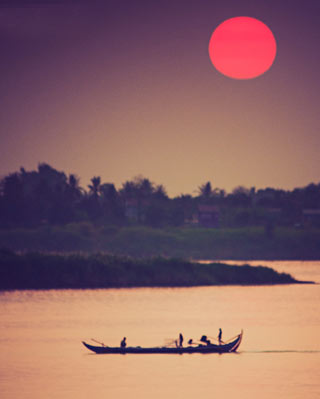Tonle Sap - The Cambodian Lake That Breathes
Located in Siem Reap, the “Great Lake” Tonle Sap is not only the beating heart of Cambodia but also Southeast Asia’s largest freshwater lake. Stretching 155 miles long and 65 miles broad at its widest point, it’s like an inland ocean with vibrant ecosystems and fascinating local communities.

Seasonal Rhythm of the Tonle Sap
The Tonle Sap is unique for two reasons: its flow runs in both directions, and the part that forms the lake swells and contracts considerably with the seasons.
During Cambodia’s dry season, which normally lasts from November to May, the Tonle Sap flows south-easterly towards the sea and connects with the enormous Mekong River about 100 kilometers (62 miles) downstream, where it splits off into many streams throughout Vietnam's immense Mekong Delta region.

However, over the wet season, monsoon winds bring heavy rains across Southeast Asia, and the Mekong River starts to swell. By around June, the water level makes the Mekong so inundated that its overflow waters follow an alternate, north-western course up the Tonle Sap River and form a massive lake, flooding nearby crops and woods and serving as a breeding site for indigenous fish species. At the end of the rainy season, the flow reverses and acts as a safety valve to prevent flooding further downstream.

At the peak of the wet season, Tonle Sap extends more than four times its size, from approximately 1,050 to 4,500 square miles and from 22 to 65 miles at its widest point. When the Tonle Sap's depth rises dramatically, from about one to nine meters, river ships can now enter the lake, and suddenly, thousands of astonishingly tall stilted houses that perch on the vast swamp make perfect sense.

Cambodian Life on the Tonle Sap
Since the dawn of history, the Tonle Sap Lake and River System has been the lifeblood that nourished a population of over one million during the glittering era of the Khmer Empire in the 12th century. This achievement is largely credited to its great position along the northern banks of the Tonle Sap, as proven by Angkor's numerous temple bas reliefs showing scenes of daily life relating to fishing and irrigation.

Nearly a millennium later, the Tonle Sap remains a source of nourishment for over three million people living in its immediate vicinity. Much as their ancient Angkorian ancestors were, fish and rice are two staples in practically every Cambodian diet, with freshwater fish accounting for two-thirds of their protein consumption.
Though the dry season causes the shoreline to retreat from under the floorboards to tens of kilometers away, the muddy Mekong flow leaves behind rich soil deposits suitable for rice cultivation. For half of the year, fishermen throughout the marshes hang up their nets instead of farming equipment.

The Tonle Sap not only provides for those living in its local neighborhood, but it also serves as a safety valve and reservoir for people further downstream in Vietnam's Mekong delta. The lake can absorb excess water and protect the southern Mekong Delta from floods after heavy rains. During the dry season, however, the Tonle Sap drainage accounts for half of the Mekong's water flow.
Wild Side of the Tonle Sap
Designated as a UNESCO Biosphere Reserve in 1997 due to its unique wetland ecosystem, Tonle Sap Lake feeds a huge seasonal population of waterbirds during the high-water season. Of the three biospheres in the area, Prek Toal, which is located northwest of the Tonle Sap, is undoubtedly the most beautiful. It is a haven for bird enthusiasts as it is recognized as the primary breeding ground for large waterbirds that are globally threatened, including the Grey-Headed Fish Eagle, Painted Stork, Black-headed Ibis, Spot-billed Pelican, and Greater and Lesser Adjutants.

When sailing into this sealike lake, visitors will catch a frequent sight of large bird flocks of different species perching on floating “shrubs,” which are actually the canopies of giant trees that have been submerged by the Mekong's rising waters.
Discover the Tonle Sap with Mekong River Cruises
An ecological treasure trove, Tonle Sap is a popular destination on the cruising itineraries of Mekong River Cruises, exploring the Lower Mekong between the gorgeous green landscapes of the Mekong Delta in southern Vietnam and part of Cambodia, such as Heritage Line’s The Jayavarman and The Jahan.

The cruise tours usually range from 5 days between Phnom Penh and Siem Reap to 8 days between Saigon and Siem Reap. An important note is that river cruises can only cross the Tonle Sap during the high-water season from mid-August to mid-November. This season can start earlier or later, depending on rainfall, and your cruise operator will keep you updated before the departure date. If the water level is low, the trip to Siem Reap will take 4-5 hours by cruise shuttle bus instead of around 45 minutes of sailing.

Clearly, the Tonle Sap not only benefits for Cambodians. For travelers from all over, it is an exceptional wonder of nature that never stops giving – an incredible collection of sights, sounds, and sensations that add to an already peculiar, culturally rich Mekong river cruise trip. If you wish to sail into this magnificent lake, please contact our cruise experts to choose the best Mekong River Cruise for your next voyage. Bon voyage!
















